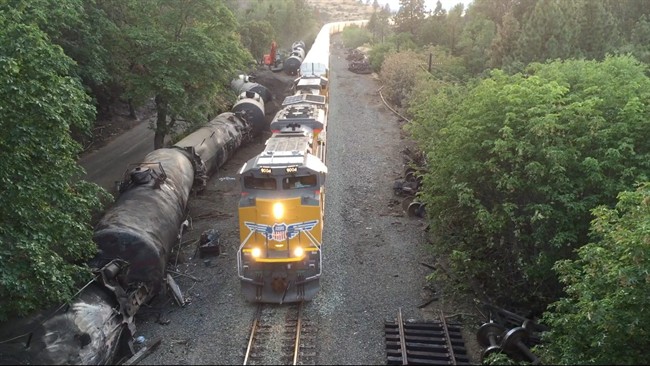BILLINGS, Mont. – Slow progress has been made on efforts to upgrade or replace tens of thousands of rupture-prone rail cars used to transport oil and ethanol, despite numerous fiery derailments that prompted new rules for the industry, U.S. safety officials said Tuesday.

Just over 10,300 stronger tank cars mandated by the new rules are available for service, according to figures obtained by The Associated Press from the Association of American Railroads.
READ MORE: Rebuilding after the Lac-Mégantic train derailment
That’s equivalent to roughly 20 per cent of the 51,500 tank cars used to haul crude and ethanol during the first quarter of 2016.
Fiery accidents and spills involving the older, rupture-prone cars have occurred in Oregon, Montana, North Dakota, Illinois, West Virginia and Canada.
In Lac-Megantic, Quebec, 47 people were killed when a runaway oil train derailed in 2013. During the most recent accident last month in Oregon, 42,000 gallons of crude oil spilled, sparking a massive fire that burned for 14 hours near the small town of Mosier in the Columbia River Gorge.
Transportation officials and rail and oil industry representatives have touted the new rules as a key piece of their efforts to prevent more accidents.

Yet National Transportation Safety Board member Robert Sumwalt told the AP on Tuesday that federal regulators need to set milestones to hold the industry accountable for getting unsafe cars off the tracks.
“There’s been 28 accidents over the past 10 years. That’s almost three accidents a year,” Sumwalt said. “Unfortunately, history shows we probably will have more accidents involving flammable liquids.”
The accident-prone cars do not have to be fully replaced until 2029, although most would have to come off the tracks sooner.
Without mandatory, periodic benchmarks for meeting the requirement, the decision to upgrade to safer tank car designs “is left entirely to tank car fleet owners, and may be driven by market factor influences, not safety improvements,” NTSB Chairman Christopher Hart said in a letter Tuesday to the U.S. Department of Transportation’s Pipeline and Hazardous Materials Safety Administration.
Transportation Department Press Secretary Clark Pettig said in response that the schedule to retrofit older cars was locked in by Congress in a transportation bill approved last year. The Congressional deadline represents “the absolute last moment” to meet the new standards, he said.
“We agree with NTSB that industry should work to beat those deadlines,” Pettig added.
A Wednesday meeting was planned in Washington, D.C., where government and industry officials were set to update the safety board on progress addressing the issue.
READ MORE: $75M settlement for Lac-Megantic victims made public: Former transport minister
Tom Simpson with the Railway Supply Institute, which represents tank car manufacturers and owners, said the industry is committed to putting stronger cars in place. Members of the group will meet deadlines for replacing or upgrading the cars, he said.
Demand for rail cars has eased as crude shipments decreased with lower oil prices, Simpson said.
“The need to modify or install new cars isn’t as urgent as when the rule was issued,” he said.
A bill from U.S. Sen. Ron Wyden of Oregon and other Democratic lawmakers would offer tax credits for companies that upgrade their cars during the next several years. Communities such as Mosier — scene of one train derailment — must be confident that companies are using the safest tank cars possible, he said.
The railroad association said only 700 of the least resilient model of the older-style tank cars remain in service. Most of the cars in current use have at least some improvements, such as shields at either end of the car to help prevent punctures during derailments.
Transportation officials cautioned, however, that thousands of idled “legacy cars” could quickly come back online if oil prices rise and shipment volumes rebound.
Most tank cars are owned or leased by companies that ship fuel by rail, not the railroads themselves. Railroad association spokesman Ed Greenberg declined comment on the progress being made toward replacing older cars.
“Every tank car carrying crude or ethanol needs to be upgraded or replaced,” he said.



Comments